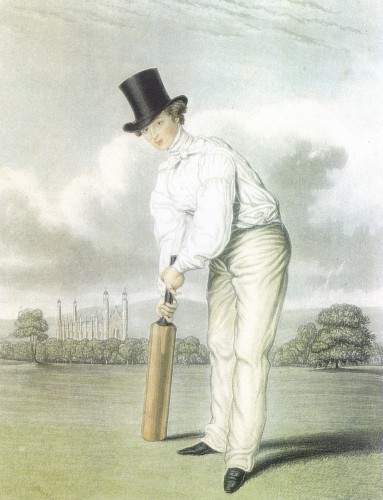This year we held the 167th Canterbury Cricket Week, in July rather than August because of the vagaries of the cricket fixture list, which gave Kent no first class games in the county during the month of August. Thus we had a Vitality Blast match against Surrey (rained off after Surrey had made 250 in their 20 overs, thus allowing us to pocket a useful point which might not have been ours had the match been played out), a Championship match against Leicestershire which we contrived to lose in two days of scorching hot weather, and another T20 game against Sussex, which was also cut short by rain. In the end, meaningful play only took place on two of the eight days set aside for the celebration of Canterbury Cricket Week, the oldest cricket festival in the world. There was no Ladies’ Day (which perhaps in this era of #MeToo is no bad thing), no link with the Old Stagers and not even the laying of the wreath at the Blythe Memorial, which had to be postponed because of the brevity of the Leicestershire match. Things have changed, and changed rapidly, in the 21stcentury.
The first Canterbury Week was held in 1842, but its roots go back a little further, to 1839. In that year, the Beverley Club, which played its home matches at St. Stephen’s Field near Canterbury, staged a match billed as “Kent versus England” on 19thAugust. Over 6,000 people came to see the great players of the day – Mynn, Pilch, Wenman and others – do battle. It was a tense and exciting tussle, eventually won by Kent by just two runs. Two years later, another Kent versus England match took place at the Beverley Club, and this time England triumphed by the somewhat larger margin of 74 runs. The match lasted a full three days, even though only 364 runs were scored in all. Perhaps it was the fact that “300 sat down to luncheon in the large booth” according to reports at the time, including many of the more aristocratic players in the match, which made the scoring so slow. All the leading county families were there, and the Beverley Club realised that a properly organised Cricket Week could well be a financial success. For 1842, a gala week in August was planned, publicised and played out.
One of the leading players in these early matches was Charles Taylor, a useful cricketer and a keen amateur actor. Taylor was born in Middlesex, played for Sussex and died in Surrey. He never played for Kent but nevertheless played an important part in the early success of the Cricket Week, both as a social and a cricketing event. When the idea of theatricals was put forward as a way of filling up the long summer evenings during the week, Taylor enthusiastically took up the challenge to make sure the plan became a reality. Charles Taylor and Frederick Ponsonby, heir to the earldom of Bessborough, had become friends at Cambridge University, and they set about forming an amateur theatrical troupe that became The Old Stagers, to add a new dimension to the enjoyment of the Week. The first performance was given on 1stAugust, 1842, in “the old and time honoured Temple of the Drama in Orange Street.”
 Charles Taylor Esq.
Charles Taylor Esq.
Taylor obviously took his theatrical duties seriously, as despite an injury that prevented him from playing in any of the cricket matches during this first Week, he was just about fit enough to take roles in three of the four the productions put on by the Old Stagers in their first ever season. The first evening was introduced by a Prologue, during which it was explained to the audience that “though our best man’s arm be out of joint, despite his splints, he’ll try and make a point.” The ‘best man’ was Charles Taylor, who was taking on the roles of Frederick Bramble in Colman’s comedy “The Poor Gentleman”, of Sir Anthony Absolute in Sheridan’s “The Rivals” and, most interestingly, of Desdemona, a striking beauty, in “Othello Travestie” “being the most excruciating Comic-Operatic-Tragedy that was ever tragedized by any Comical and Pastoral Company of Tragical Tragedians”. He had suffered a serious injury some weeks before while playing cricket and was playing all these roles with his arm in splints and a sling. I am not sure that the production of Othello with Desdemona (a striking beauty) played by a swarthy bloke with his arm in splints would have been the highlight of the week, but the Canterbury newspapers were full of praise: “The delicate Desdemona and her waiting woman Emilia (played by a military gentleman, M.G. Bruce Esq.) continually drew forth bursts of laughter by their feminine behaviour.” We have very faded photographs of both Charles Taylor and Col. M.G. Bruce in later life, and neither man looks particularly feminine.
The following year saw Charles Taylor back on the cricket field, scoring runs and taking wickets for England against Kent and for the Gentlemen of England against the Gentlemen of Kent, and also reprising his success as Desdemona. In 1846, after featuring in the celebrated single-wicket match at Lord’s between Alfred Mynn and Nicholas Felix, he again played for England against Kent during Cricket Week and played the part of “Ready” in the play, “You Can’t Marry Your Grandmother”.
In 1847, Canterbury Cricket Week moved its playing headquarters to the St. Lawrence Ground, and Charles Taylor is no more noted among the lists of players, either on the field or in the theatre on Orange Street. He must have made his move to Sussex by this time. He continued playing occasionally for Sussex until 1854, by which time he was 37 years old. He never played for the Kent county side, but his contribution to the initial success of Canterbury Cricket Week should not be forgotten.
0 Comments